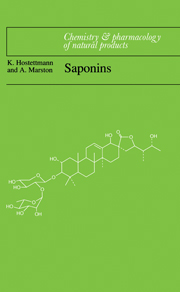Book contents
- Frontmatter
- Contents
- Glossary
- 1 Introduction
- 2 Occurrence and distribution
- 3 Analysis and isolation
- 4 Structure determination
- 5 Triterpene saponins – pharmacological and biological properties
- 6 Steroid saponins and steroid alkaloid saponins: pharmacological and biological properties
- 7 Commercially important preparations and products
- Appendices
- References
- Index of Latin names
- General index
3 - Analysis and isolation
Published online by Cambridge University Press: 19 October 2009
- Frontmatter
- Contents
- Glossary
- 1 Introduction
- 2 Occurrence and distribution
- 3 Analysis and isolation
- 4 Structure determination
- 5 Triterpene saponins – pharmacological and biological properties
- 6 Steroid saponins and steroid alkaloid saponins: pharmacological and biological properties
- 7 Commercially important preparations and products
- Appendices
- References
- Index of Latin names
- General index
Summary
An important aspect of the modern use of plant extracts as pharmaceutical preparations is the characterization and determination of the individual active constituents. Such is also the case for saponin preparations, which often require sophisticated techniques for the isolation, structure elucidation and analysis of their component triterpene and steroid glycosides. When biological testing of the pure compounds is to be performed, it is necessary to isolate them in sufficient quantity and purity. As many foodstuffs contain saponins, their isolation and characterization is vital in order to investigate their biological activities and possible toxic effects.
A large body of work on the isolation of saponins comes from Japan, where there is great interest in the constituents and pharmacological properties of Oriental drugs, many of which contain either triterpene glycosides or steroid glycosides.
Techniques of isolation (to be found in Section 3.2, together with extraction methods) and structure elucidation described in this book put an emphasis on the triterpene glycosides. The other classes of saponins (steroid glycosides, steroid alkaloid glycosides) rely on the same or similar methods of chromatography and spectroscopic/chemical analysis (e.g. MS, C-NMR, acid hydrolysis, enzymatic hydrolysis, alditol acetate formation, etc.). As far as steroid alkaloid glycosides are concerned, alternative isolation methods relying on the basic nature of the nitrogen atom can be employed (see below). Exceptions and special cases are mentioned in the relevant sections.
- Type
- Chapter
- Information
- Saponins , pp. 122 - 174Publisher: Cambridge University PressPrint publication year: 1995

